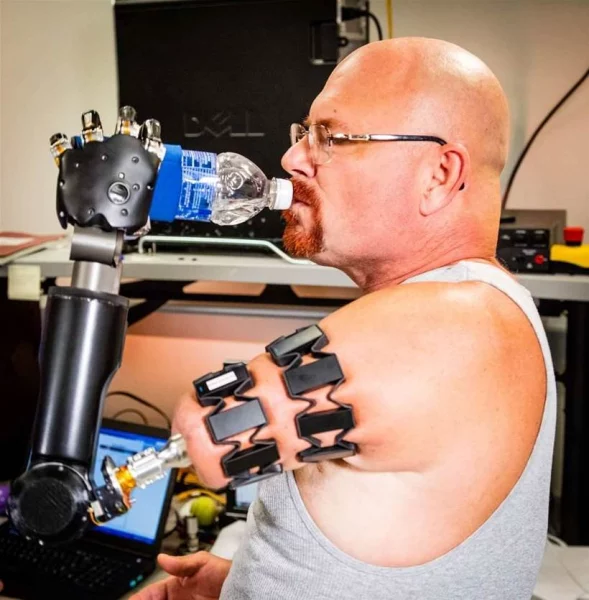Prosthetic arm technology has made significant strides in helping individuals with disabilities regain mobility. Recently, a groundbreaking invention called the Modular Prosthetic Limbs, developed by researchers at the Johns Hopkins Applied Physics Laboratory (APL), has ushered in a new era for those who have lost the ability to move. This technology, in particular, allows users to control the movements of both arms simultaneously, something previously unheard of in the field of rehabilitation.
The modular prosthetic arms are designed with separate modules that can be flexibly adapted to the patient’s needs. To use this technology, patients must undergo a complex surgical procedure called targeted muscle reinnervation. This method helps reconnect nerve signals to the muscles, enabling the brain to control the prosthetic arm movements via electrical signals. This technique not only allows patients to use the prosthetic arm but also helps them perform complex actions such as grasping, moving, or performing tasks simultaneously with both hands.
“With this technology, patients can not only control one prosthetic arm but can simultaneously control both arms, which is completely new in the field of rehabilitation,” according to experts at Johns Hopkins University Applied Physics Laboratory (APL).
This breakthrough brings a significant advancement in restoring function to patients who have lost their ability to move due to accidents, illness, or other reasons.
This research has been successfully tested on animals, with paralyzed mice able to move on a treadmill with the help of the prosthetic arms. Notably, for the first time, scientists have demonstrated that a simple device can help restore the ability to walk and be accepted by the body. This experiment marks an important step, as the modular prosthetic arm technology has proven its feasibility in restoring mobility to animals.
This technology not only opens up great opportunities for people with disabilities but also provides a new perspective on the potential applications of neuroprosthetics. These devices not only help restore motor function but can also change the way humans interact with the world around them. With the ability to control both arms simultaneously, users can perform complex tasks such as cooking, driving, or even engaging in sports activities.
“We have just begun to explore the possibilities of this technology. In the future, this technology could be further developed to help restore not only the arms but other parts of the human body,” the researchers emphasized.
Clinical trials on humans are expected to be conducted in the near future. Although there are still many issues to resolve regarding durability, compatibility with the human body, and cost, these initial steps have sparked hope for millions of people with disabilities around the world, helping them live a more independent and normal life.

With impressive results from preliminary tests, the modular prosthetic arm technology is sure to become one of the most important advances in the fields of medicine and rehabilitation technology. These developments not only bring hope to people with disabilities but also open the door to a future where technology and humans can integrate and support each other comprehensively.


HPX24h > Science > Modular Prosthetic Limb Technology: Breakthrough Discovery Enhances Motion for Disabled Individuals
Top Reads from This Category
Science
Mind-Controlled Prosthetics: A Groundbreaking Advancement in Medicine
Science
The Secret of the Bee Brain: New Technology Enables Drones to Fly Independently
Science
The Mystery of the Brain Network that Regulates Human Attention Has Been Unveiled
Science
NSF Workforce Cuts – Which Path Will the U.S. Take to Stay Competitive in the Global Tech Race?
Science
AI Can Make Life Easier, But Is It Harming Your Ability to Think Critically?
Science
The Shocking Truth About Medical Bandages: Harmful Chemicals Absorbed Through Wounds
Science
Discover Blood Testing Technology Without a Visit to the Doctor
Discover New Topics
Fitness
Aerobic and Anaerobic: The Right Training Secrets for Overall Health and Strength
Health
5 Essential Things Every Woman Should Know About Menopause
Science
Discovery of a New Stem Cell: A Major Advancement in Creating Human Organs
Science
Modular Prosthetic Limb Technology: Breakthrough Discovery Enhances Motion for Disabled Individuals
Health
Daily Habits to Naturally Manage Blood Pressure Without Medication
Fitness
Muscles: The Golden Key to Effective Health and Performance
Fitness
Physical Training: The Key to Preventing Nerve Damage During Chemotherapy
Science
New Hope from Cyborg Spinal Implant Technology for Paralyzed Patients
Parenting Tips
How to Prevent a 2-Year-Old from Throwing Things?
Fitness
Effective Workout Tips: The Best Full-Body Exercises for Health
Science
Science Could Regrow Your Lost Arm… on a Monkey’s Body
Science
A New Drug Could Treat Depression Within Just 24 Hours
Science
Stem Cell Therapy for Lung Cancer: A New Hope Entering Human Trials